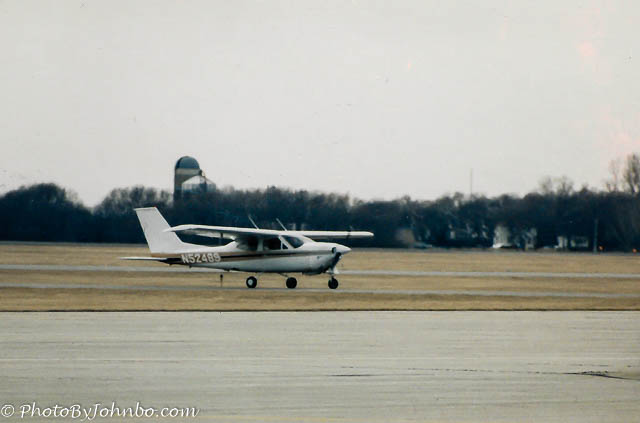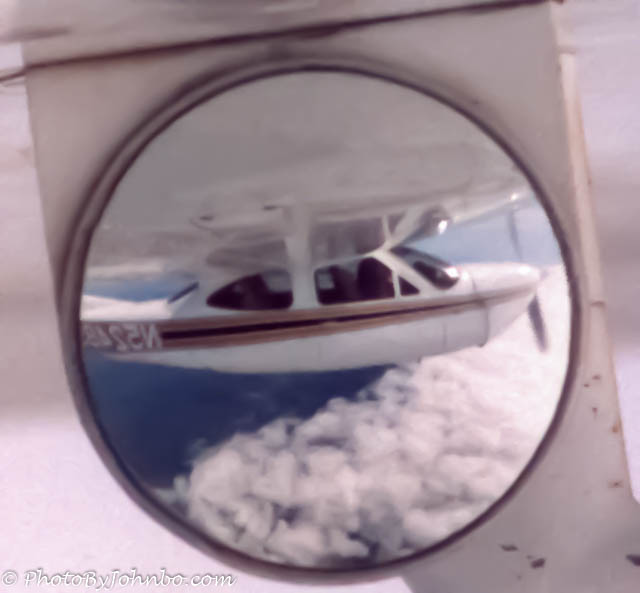It’s been two decades since I started flight training. What possessed a 47-year-old to become an aviator? Who knows… maybe it was my mid-life crisis, maybe it was looking for some adventure. In any case, this story is about our first trip to Lynchburg, and about travelling in a private aircraft. Fast forward to June 2001 and this private pilot of only four years decided to purchase a quarter-share of an airplane. One of the partners in the aircraft was moving on and his 25% stake was available for purchase. The Cessna Cardinal RG is a complex aircraft, simply meaning it has an adjustable propeller and retractable landing gear. Both these features and a larger engine than I was used to flying required some extra training time and gave me new aircraft management skills to learn. At first, I was a bit skittish about the retractable gear. After all, I’d heard many times there are two kinds of pilots, those who have landed an airplane with the gear up, and those who will. But I digress from this digression.
The Cardinal became a primary means of longer distance transportation for my wife, Lynn, and I. The opening photo features one of our first photos with our new acquisition in 2001. By 2007, we were used to travelling, and being delayed by weather, and having to divert around weather systems. It turns out that small private planes are not well equipped for all weather flying. With safety as number one priority, I acquired an instrument rating so that I could fly through some weather situations, and always avoid hazardous weather. Our rule is that weather delays are part of the travel experience. We were able to visit some unexpected places when the weather forced us to find a place to land and wait it out.
 This trip to Tennessee wouldn’t be the longest flight I’d made. We’d travelled to Albuquerque and I’d flown with my brother and his wife to San Diego as well. Lynn has always been comfortable flying with me because she knows I don’t take chances when it comes to safety of flight. Our plan to the Lynchburg reunion was simple, up early, fly to Effingham, Illinois where we would stop for fuel and a lunch break, then on to Tullahoma, the nearest public airport to Lynchburg where we reserved a rental car for the few days of our reunion. The photo above shows the Cardinal as we taxied into airport parking at Glasgow, Montana in 2003. One of my family members met us at the airport and took a few photos of our arrival.
This trip to Tennessee wouldn’t be the longest flight I’d made. We’d travelled to Albuquerque and I’d flown with my brother and his wife to San Diego as well. Lynn has always been comfortable flying with me because she knows I don’t take chances when it comes to safety of flight. Our plan to the Lynchburg reunion was simple, up early, fly to Effingham, Illinois where we would stop for fuel and a lunch break, then on to Tullahoma, the nearest public airport to Lynchburg where we reserved a rental car for the few days of our reunion. The photo above shows the Cardinal as we taxied into airport parking at Glasgow, Montana in 2003. One of my family members met us at the airport and took a few photos of our arrival.
The flight to Effingham went without a hitch. We landed, refueled and then borrowed the airport courtesy car for a quick trip to a nearby cafe for lunch. Flight time from Effingham to Tullahoma in under two hours, about half the time of our morning trip from Fargo to Effingham. We would be in Tullahoma by mid-afternoon, or so we thought… After lunch, we loaded ourselves back into the airplane and departed Effingham uneventfully. About thirty minutes into the flight, however, I noticed a problem.
During my normal instrument scan, I noticed that the ammeter wasn’t in its normal mid-point indication. the needle was all the way left, indicating that we might be running our electrical system totally on battery. At this point, I realized we would need to stop somewhere to confirm and repair as needed. It was certainly possible that the gauge quit operating, and probably more likely, the alternator quit operating. For those who might be wondering, I wasn’t worried about the engine quitting. Airplane engines typically don’t depend upon the aircraft electrical system to keep operating, a system of dual magnetos ensures continued spark to ignite the fuel in the cylinder chambers, even with a dead battery.
Of greater concern is that “those pilots who will land gear up.” It could just be my turn. OK, I’m exaggerating here. The landing gear is hydraulic, but the pump is powered by electric motor. If the battery died, I could still resort to muscle power and “pump” the gear down using the hand pump handle that is stowed between the two front seats. Losing the battery meant losing communications with air traffic control (ATC), my immediate concern. I immediately scanned the instrument panel and shut off all unnecessary electrical gear, the secondary radio, strobe lights and, of course, our music source. I left on one working radio and the GPS. I needed to conserve battery to be sure I had enough energy left to bring down the landing gear. Old time pilots will probably tease me about leaving on the GPS when I could easily navigate by chart. True enough, but using GPS capabilities of calculating distance and bearings to nearby airports would be less hassle.
Next decision… where to land? There were several nearby airports on my chart, but not all of them have facilities to service an aircraft without adding the extra expense of flying in a mechanic to repair the aircraft. Looking at my flight charts, the biggest nearby city would be a short diversion to the east at Evansville, Indiana. The airport there would be large enough to have a full service aircraft maintenance facility, a Fixed Base Operator (FBO) in aviation speak. I dialed up Evansville on the GPS. It gave me a heading and estimated time enroute of 20 minutes. I turned to that heading, shut off the GPS, and navigated by old-fashioned “pilotage”.
As I was on an instrument flight plan, I was already communicating regularly with ATC. I told the controller of my issue and that I would be diverting to Evansville, further that I would keep my communications to a minimum. I gave ATC my modified flight plan and the friendly controller advised that I no longer needed to reply to any instructions via the radio. ATC would contact Evansville Tower to let them know I might be coming in NORDO (without a working radio).
With an abundance of caution, I decided to lower the landing gear sooner rather than when we arrived. Having the gear down and locked would slow us, adding a few minutes to the trip, but the major electrical load remaining would be behind us. Fortunately, I caught the loss of electrical in plenty of time. I had no radio loss issues. Our landing at Evansville was uneventful, and I even had enough battery left to restart the engine when I discovered I’d parked in the wrong area for maintenance. After agreeing to the $100 immediate service charge, we were the recipients of the diagnosis. The alternator had indeed quit operating. The bad news was that one would have to be ordered and it might be a couple of days. Ah, yes. Time to spare, go by air.
We rented a car from the airport car rental agency and proceeded to drive to Lynchburg, only about four hours from Evansville. We were in town in plenty of time for the reunion and two days later, we got a call from the FBO. Our aircraft was repaired and fully ready to go. We finished our time at the reunion, drove back to Evansville, picked up our plane and headed home. This time, our overnight was at Clear Lake, Iowa. We stopped there purposely as it was a convenient midpoint for refuel and the airport has a historic and tragic relationship with the music industry. It was at Clear Lake where Buddy Holly, Richie Valens and J P Richardson died in a crash on take-off. Their destination was Fargo, on the way to a concert in Moorhead, Minnesota, our next-door neighbor city.
Postscript: The photo above is my favorite photo of the Cardinal. In order to meet insurance requirements, as part of my complex aircraft training, I needed to fly 10 hours unaccompanied by passengers. I took several trips including one to Ironwood, Michigan. The photo above is a closeup of my landing gear mirror captured on that trip. The mirror is there to confirm that the gear is down and locked for landing. At 10,500 feet, I was flying with the aid of the autopilot. The digital camera I had at the time did not have a telephoto lens, nor did it have much for resolution. This fuzzy picture is the result of cropping and enlarging the image to focus on the mirror which, as you can see by the reflection, is several feet from the fuselage.
Since wintering in Arizona, I haven’t had as much time for flying the Cardinal in recent years. Last summer I sold my share and N52489 is now a memory in my flight logs.
John Steiner



47 is a better age to do these things than waiting late to start your bucket list – right?
Absolutely.
Styling! love it!Enjoy
What an adventure – good for you for keeping your cool!! Hope you’ve found something fun to replace her!
😎
Good for you for finding your passion! I love airplanes, which is why I worked in aviation for so long. (Commercial, civil aviation.) But I could never imagine flying a plane! You really have to be very certain of yourself and be able to make quick decisions. I admire pilots!
Thank you. Learning to fly gives you a lot of self confidence once you get past the feeling that everything seems to happen at once. 😀
Whew! I’ve never heard this story before. You have nerves of steel! These events would’ve turned me into a puddle. LOL
Pilots learn what is dangerous and what is not. I knew this wasn’t a major issue and knew the procedures to manage it. More complicated problems are quickly managed by checklists that are at hand in a small binder. These procedures are practiced regularly by pilots during recurrent flight training.